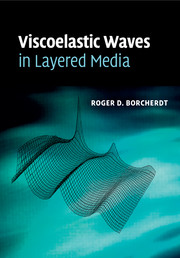Book contents
- Frontmatter
- Contents
- Preface
- 1 One-Dimensional Viscoelasticity
- 2 Three-Dimensional Viscoelasticity
- 3 Viscoelastic P, SI, and SII Waves
- 4 Framework for Single-Boundary Reflection–Refraction and Surface-Wave Problems
- 5 General P, SI, and SII Waves Incident on a Viscoelastic Boundary
- 6 Numerical Models for General Waves Reflected and Refracted at Viscoelastic Boundaries
- 7 General SI, P, and SII Waves Incident on a Viscoelastic Free Surface
- 8 Rayleigh-Type Surface Wave on a Viscoelastic Half Space
- 9 General SII Waves Incident on Multiple Layers of Viscoelastic Media
- 10 Love-Type Surface Waves in Multilayered Viscoelastic Media
- 11 Appendices
- References
- Additional Reading
- Index
9 - General SII Waves Incident on Multiple Layers of Viscoelastic Media
Published online by Cambridge University Press: 29 October 2009
- Frontmatter
- Contents
- Preface
- 1 One-Dimensional Viscoelasticity
- 2 Three-Dimensional Viscoelasticity
- 3 Viscoelastic P, SI, and SII Waves
- 4 Framework for Single-Boundary Reflection–Refraction and Surface-Wave Problems
- 5 General P, SI, and SII Waves Incident on a Viscoelastic Boundary
- 6 Numerical Models for General Waves Reflected and Refracted at Viscoelastic Boundaries
- 7 General SI, P, and SII Waves Incident on a Viscoelastic Free Surface
- 8 Rayleigh-Type Surface Wave on a Viscoelastic Half Space
- 9 General SII Waves Incident on Multiple Layers of Viscoelastic Media
- 10 Love-Type Surface Waves in Multilayered Viscoelastic Media
- 11 Appendices
- References
- Additional Reading
- Index
Summary
The response of a stack of multiple layers of viscoelastic media to waves incident at the base of the stack is of special interest in seismology. Solutions of the problem for elastic media with incident homogeneous waves have proven useful in understanding the response of the Earth's crust and near-surface soil and rock layers to earthquake-induced ground shaking. Solutions are provided here for general (homogeneous or inhomogeneous) SII waves incident at the base of a stack of viscoelastic layers. The derivations of solutions for the problems of incident general P and SI waves are similar, but more cumbersome. The method for deducing solutions of the incident P and SI wave problems will be illustrated by those developed here. The results provided here for viscoelastic media include those derived for elastic media (Haskell, 1953, 1960). The method used here to derive the solutions for viscoelastic waves uses a matrix formulation similar to that initially used by Thompson (1950) and implemented with the correct boundary condition for elastic media by Haskell (1953).
To set up the mathematical framework for multilayered media consider a stack of n – 1 parallel viscoelastic layers in welded contact underlain by a viscoelastic half space. Spatial reference for the layers is provided by a rectangular coordinate system designated by (x1, x2, x3) or (x, y, z) as shown in Figure (4.1.3) with the plane x3 = z = 0 chosen to correspond to the boundary at the free surface. The layers are indexed sequentially with the index of each layer corresponding to that of its lower boundary as indicated in Figure (9.1.1).
Information
- Type
- Chapter
- Information
- Viscoelastic Waves in Layered Media , pp. 246 - 261Publisher: Cambridge University PressPrint publication year: 2009
